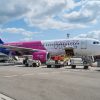 The emergence of new aviation technologies, from artificial intelligence (AI) to advanced air mobility, robotics, uncrewed aircraft, ultralight materials, cloud-based data systems, 3D printing, alternative fuels, biometrics, Big Data, and the internet of things (IoT), these advancements are redefining the aviation discourse, given their profound impacts on air transport systems. However, the World Economic Forum (WEF) has noted that most of these innovations may fail to produce the expected value and transformations in the air mobility landscape due to insufficient regulatory frameworks to guide their deployment.
The emergence of new aviation technologies, from artificial intelligence (AI) to advanced air mobility, robotics, uncrewed aircraft, ultralight materials, cloud-based data systems, 3D printing, alternative fuels, biometrics, Big Data, and the internet of things (IoT), these advancements are redefining the aviation discourse, given their profound impacts on air transport systems. However, the World Economic Forum (WEF) has noted that most of these innovations may fail to produce the expected value and transformations in the air mobility landscape due to insufficient regulatory frameworks to guide their deployment.
Current predictions indicate that the aviation industry will experience a 46.4% CAGR growth in AI application by 2023. The trend may replicate with other technologies, providing personalized and optimized travel experience for air travelers, supporting democratizing decision-making processes, and eliminating uncertainties in air travel.
Unfortunately, under unexpected circumstances, these technologies may exacerbate transport issues, create new risks, or cause inefficiencies, which may affect the sustainability of the existing air transport systems in unprecedented ways.
Within the 2030 Sustainability Agenda framework, ICAO assumes the role of the custodian agency, which encompasses providing global indicators for industry growth and progress in such areas as technology within the aviation sector. ICAO’s role involves monitoring and gathering data on aviation infrastructure and efforts that different countries have taken to foster innovation and promote sustainable industrialization. However, the central question revolves around how aviation regulations influence technology deployment and the shift towards sustainable mobility.
From a regulatory perspective, there is a need for more regulation to enable operational testing for emerging aviation technology before their deployment. According to a report on Aircraft Technology Roadmap (ATR) to 2050, the IATA expresses the need to review existing regulations and aviation standards to ensure that the deployment of the emerging technologies does not impede the climate action goals that aviation stakeholders have committed to.
Current forecasts indicate that the birth of new aviation technologies may accelerate the rate of air passenger traffic to about 3.7% annually, which would translate to more pollutant emissions from this industry. However, aviation stakeholders have committed to reducing their net environmental footprint by 50% by 2050. This calls for more regulations and market-based measures to achieve a controlled deployment of emerging aviation technologies and reduce their associated adverse environmental outcomes.
The Clean Sky-2 Joint Technology Initiative (CSJTI) reflects what aviation stakeholders from the European Union (EU) are doing to regulate innovative aviation technologies and harness their capabilities to achieve a “highly cost-efficient air transport system” and build a sustainable innovation ecosystem and operational environments using “ultra-green” technologies. ICAO maintains that regulatory measures must become the mainstay of innovation and deployment of future aircraft and aviation technology. The regulation of aviation technologies should focus on compliance with existing standards including environmental, design specifications, and operational aspects.
Despite the compelling need for technology regulation, such efforts should not create an impediment or a barrier that may limit future innovation. For this reason, the regulatory process should take a double-pronged approach that focuses on providing flexible and forward-looking legislation. The aftermath is a practical operational framework that incentivizes professionals in the aviation industry to bring safe, secure, and sustainable state-of-the-art aviation technologies and solutions.
For example, the regulation for autonomous, non-piloted, or uncrewed aircraft should levitate on the design standards and legislation that specify their use of Beyond Visual Line of Sight (BVLOS). The regulation should also respond to the “safety aspect” and risk management processes to ensure that the deployment of aviation technologies does not pose a safety risk to pilots, passengers, and the public. Other areas to focus on in safety regulation include integration and interoperability with other systems in the airspace and need for maintenance.
As part of regulation, the operators of upcoming aviation technology must ensure that these innovations meet insurance compliance requirements. Such regulations offer a mechanism to safeguard the operators from any liabilities and other costs resulting from unforeseen incidents.
The regulation should target imposing controls on the development and operation of aviation technologies that have the potential to compromise physical and cyber security when deployed.
As such, the regulation should respond to the security issues emanating from specific technologies, including unlawful interference and the democratization of technology-related security threats that affect civilian aviation systems, including reservation systems, passport control systems, cloud-based data systems, and departure control systems, and so on.
Markedly, as airlines recover from Covid-19 pandemic shocks, staff shortage issues have become increasingly ubiquitous in many airports. Employees have expressed dissatisfaction with their work environments, citing unfair treatment, increased work pressure, long working hours, and a lack of morale, a situation that has compelled many to resign from their jobs, leading to staff shortage problems. For some airlines, the staffing disruption has resulted from early retirement packages and layoffs that many airports initiated at the start of the pandemic. These disruptions have created a chaotic situation in many airports, impeding routine operations.
The ongoing technology advancements have presented significant benefits for the aviation industry but have left stakeholders at crossroads on as airlines lack staff to execute these trends. The greater sprawl of aviation technology has also raised a constellation of safety, security, and operational issues that necessitates a proactive approach toward their regulation.





